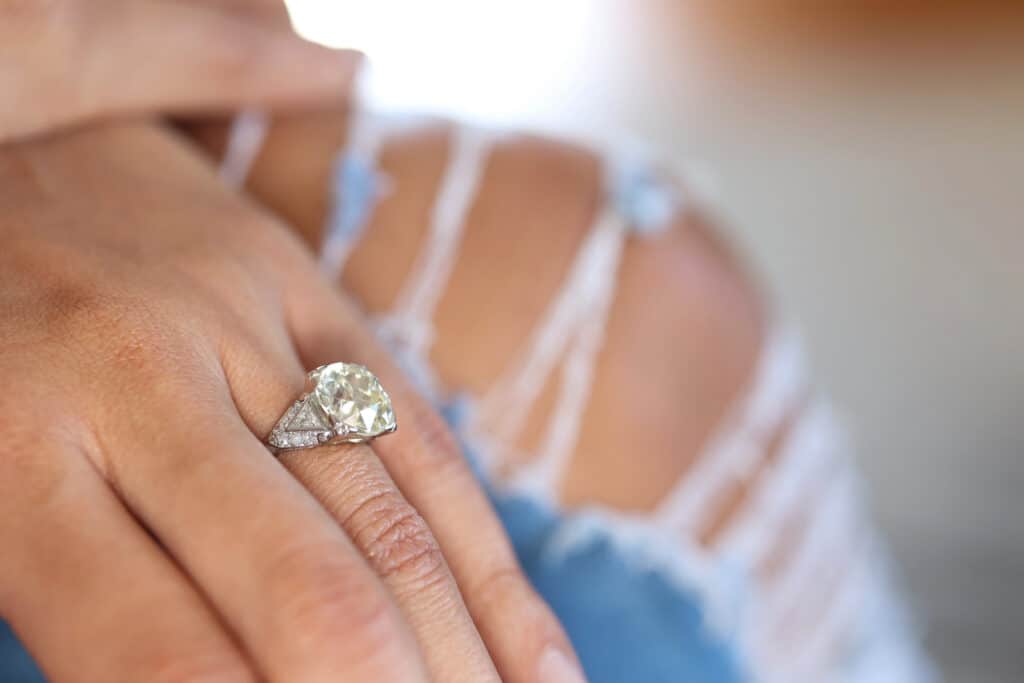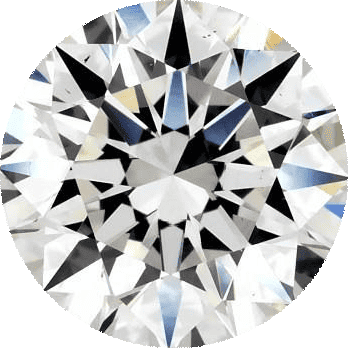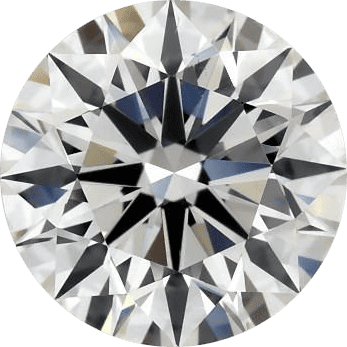What are Antique Diamond Cuts?
Antique cut diamonds are diamonds that were mined and cut anywhere between the 1300s and the 1930s. Several varieties of antique diamond cuts exist in the market, depending on the time period and jeweler who cut the stone.
Most antique cut diamonds offer a very romantic and soulful appeal. Their most distinguishing characteristic is that they’re not as blingy or sparkly as most modern cut stones.
Instead, antique cuts often feature larger faceting and a softer look. Many antique diamonds were meant to be viewed in the candlelight, offering a soft glow and romantic feel. Many people are attracted to the antique appearance of these cuts, especially if they appreciate vintage styles.
Just like modern cut diamonds, antique cut diamonds can vary in value based on their beauty, carat weight and other factors. A diamond’s age and history can also play a role in how much it’s worth, especially if the stone is of special historical or cultural significance.

Why you should trust us
Bottom Line Recommendation:
Antique cut diamonds offer a beautiful, soft appearance when compared to modern cut diamonds. They make an excellent choice for those who particularly appreciate antique and vintage styles. Custom-made settings are usually crafted for these stones—giving you the opportunity to design a completely customized ring. Antique cut diamonds are also environmentally-friendly and socially responsible, as they require little impact on the environment and people.
Most importantly, we recommend purchasing antique diamond cuts from a reputable vendor, like Abe Mor Diamonds. Different than buying from an estate sale or second-hand store, you’ll receive a high-quality, certified diamond with Abe Mor.
For personal assistance in finding a stunning antique diamond, send our experts an email.
Types of Antique Diamond Cuts
There are several different types of antique diamond cuts. Many of these cuts date back several centuries, with the oldest originating in the 1300s. Below, we’ve listed the most common vintage and antique diamond cuts:
Single Cut
The single cut features eight crown facets and eight pavilion facets. Dating back to the 1300s, this antique diamond cut is set apart from others by its octagonal shape and its simple, elegant design. Single cut diamonds are also known as eight cuts.
Rose Cut
The rose cut features anywhere from three to 24 facets. It’s one of the oldest diamond cuts, with a history dating back to the 1500s. This diamond cut is known as the rose cut because its shape resembles that of a rose bud’s bloom.
Unlike many other diamond cuts, a rose cut diamond features a flat bottom with a dome-shaped crown, allowing the facets to meet in the center at an apex.
Symbolizing romance and love, the rose cut diamond remained popular during the Georgian (1714-1837) and Victorian (1837-1901) eras. More recently, it’s experienced a resurgence due to the rose cut engagement ring that Jennifer Anniston received from Justin Theroux in 2012.
Old Mine Cut
The old mine cut features a square-shaped girdle with slightly rounded corners. If you’re familiar with popular diamond cuts, you may have noticed that it resembles the modern cushion cut, with a slightly square shape that sets it apart from other antique diamond cuts.
Old mine cut diamonds first appeared on the jewelry scene in the early 1700s and were popular during the Georgian and Victorian eras. Their distinctive shape is a result of jewelers aiming to minimize the loss of the rough diamond and maximize carat weight.
“From the early 18th century to the late 19th century, the old mine cut was perhaps the most common diamond cut and the cut you’ll most often find in Georgian (1714-1837) and Victorian era (1837-1901) jewelry.” “Due to the shape of the rough and because the diamonds were hand crafted, dimensions varied from stone to stone. This made every old mine cut diamond unique, or put poetically, have its own personality.” Gemological Institute of America (GIA)
Diamonds of this type are known for having a large culet, deep pavilion, small table and a high crown. With 58 facets, just like the modern round brilliant cut, the old mine cut’s asymmetrical shape offers a distinguished, lively and poetic feel.
Old European Cut
The old European cut is round in shape, with an appearance that’s similar to the modern round brilliant cut diamond like this one on James Allen. Unlike a modern round brilliant, the old European cut is cut less precisely and is, as a result, more organic in shape.
The old European cut is regarded as the most advanced antique cut. Its stunning, organic feel makes it a vintage favorite.
Dating back to the late 1800s, the old European cut remained a prevalent design throughout the late Victorian era, Edwardian era (1901-1910) and Art Deco period (1920-1930s). Similar to the old mine cut, old European cut diamonds feature a small table, high crown and large culet, although the culet is smaller than that of the old mine cut.
Why Choose an Antique Cut Diamond?
There are two main reasons to choose a vintage cut diamond.
First, if you love antiques and a more timeless style, an antique cut stone might be ideal for you. Rather than owning a diamond that’s similar to what others have, you’ll be wearing a stone that’s truly one-of-a-kind. Plus, it provides a classic, romantic feel to your ring.
Second, if you desire a more sustainable choice, an antique diamond fits that need as well. You’re selecting a diamond that’s being repurposed rather than causing the environmental and social impact of mining a new diamond.
Choosing a conflict-free diamond from a sustainable source is becoming increasingly popular. And with a vintage cut diamond, you can feel the peace of mind knowing you chose a stone that is environmentally-friendly and socially conscious.
The Pros and Cons of Antique Cuts
If you’re looking to purchase an antique cut, you might be curious as to the advantages and disadvantages of this decision. We’ve laid out the main considerations below.
Warmer Coloring
Most of the rough diamonds that came out of the ground a few hundred years ago came from mines that produced warmer-colored diamonds. That’s why many antique cut diamonds fall in the J, K, L and M diamond color grading, even down to the P, Q and R tones. Some people like the charm of these colors because they don’t look as glitzy or blingy and offer an antique appeal. Others enjoy the brighter white-colored diamonds, like those in the G, H and I ranges like these from James Allen.
Less Expensive
Antique cuts tend to be less expensive than modern cuts. They don’t require new mining and all of the associated costs. In general, an antique cut of a similar carat weight will be 20% less expensive than a new modern cut. This is an advantage to buyers that allows them to save money—or spend more of their budget on an ornate, unique setting.
Environmentally Conscious
Opting for a vintage cut stone is more sustainable and environmentally-friendly than choosing a newly mined diamond. Although the diamond industry has many positive effects for the countries in which it operates, mining for new diamonds can, in many cases, contribute to soil erosion and deforestation.
Without a doubt, you’re reducing your environmental and social impact by choosing an antique stone. You can have peace of mind knowing that you’re purchasing a safe and sustainable gemstone that has no further negative impact on the environment.
Harder to Find
Walking into a jewelry store or searching online dealers, it’s unlikely that you’ll find a selection of antique cuts. Usually, vintage cuts are found in high-end stores that carry specialized estate jewelry and antique diamonds. That’s right: antique and European cuts are niche items.
While we often recommend James Allen and Blue Nile to our readers, they don’t carry antique and Old European cut stones.
On the other hand, Abe Mor, a specialty diamond vendor based in New York City, does carry a variety of antique cuts. They buy second-hand and estate jewelry, and maintain one of the largest inventories of antique cut diamonds. They consistently carry hundreds of beautiful antique diamonds to choose from. We recommend viewing their diamond collection or sending them an email if you’re interested.
Opportunity for a Truly Unique Ring Setting
Most antique cuts are sold as loose diamonds. The actual antique settings are often problematic. They are old, the stones have a likelihood of falling out and the metal may be too thin. That’s why you’ll have an opportunity to help design a custom setting that matches your style.
You can choose to design an entirely new ring setting. Or you can find an antique ring that you love either online or at an auction. Then, you can ask the jeweler to replicate it exactly. Luckily, jewelers today craft ring settings with extreme precision, including ornate touches and filigrain detailing.
GIA Certified
Just because antique diamonds were cut hundreds of years ago doesn’t mean they don’t come with a legitimate certificate. European and antique cuts on the market today are usually certified. That means you’ll receive verification with your purchase as to the diamond clarity, color, cut quality, carat weight and more. As with all diamonds, we recommend only choosing stones that are certified by the most reputable lab entity (GIA).
Colored Diamonds Options
Antique cut collections include more than white colored diamonds. Colored diamonds are also an option. In fact, many fancy yellow diamonds were produced during the antique periods. You can find stunning, vivid yellow diamonds from reputable sellers.
Colored gemstones are also available in antique cuts.
Where to Buy Antique Cut Diamonds
Finding an antique cut diamond is more difficult than finding a modern cut stone. Most jewelry stores and online vendors don’t carry vintage and Old European cut diamonds.
That’s why we recommend Abe Mor, a highly reputable vendor that specializes in antique diamonds and estate jewelry. They maintain one of the largest inventories of antique cut diamonds.
You can look through the Abe Mor online inventory or contact them directly. They can send you high-quality videos and photos of any antique diamond before purchase, and guarantee that buyers don’t have to keep a diamond they’re not satisfied with.
If you’d like personal assistance in finding an antique diamond, don’t hesitate to contact our diamond experts.

- No questions asked returns within 30 days of shipment. James Allen will send you a paid shipping label to return the ring.
- Lifetime Warranty
- Free International Shipping
- Free prong tightening, repolishing, rhodium plating and cleaning every 6 months
- Provide insurance appraisals
- One free resizing within 60 days of purchase
- Free ring inscriptions
- Best-in-class high quality imagery of all diamonds in stock
- 24/7 Customer Service
- Best-in-class packaging


- No questions asked returns within 30 days of shipment. Blue Nile will send you a paid shipping label to return the ring.
- Lifetime Warranty
- Free Shipping
- Free prong tightening, repolishing, rhodium plating and cleaning every 6 months
- Provide insurance appraisal
- One free resizing within the first year of purchase
- High quality images of about half of their diamonds
- 24/7 Customer Service
- 100% credit towards future upgrades (must be at least double in value)
- Best in class fulfillment

Still afraid of getting ripped off?
Before you buy a diamond, get personal buying advice from industry veterans. We'll help you get the best diamond for the money.
Ask your diamond purchase question here
DISCLAIMER: We don't use your email for marketing. Period.
You Might Like
Diamond Prices: A Complete Guide
A diamonds’ price is determined primarily by the 4 Cs of the diamond. On the wholesale level, diamond prices are first based on a diamond shape and
The Best Places to Buy Engagement Rings
Buying an engagement ring is often one of the first major purchases in a person's life. The process can be fraught with tension as there are so m
1 Carat Diamond Price & Buying Guide
A wide range of 1 carat diamonds exist both in online markets and local diamond jewelry stores. Not only are there significant differences in beauty






